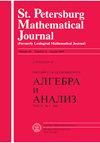The set of zeros of the Riemann zeta function as the point spectrum of an operator
IF 0.6
4区 数学
Q2 MATHEMATICS
引用次数: 0
Abstract
A possible way of proving the Riemann hypothesis consists of constructing a selfadjoint operartor whose spectrum coincides with the set
作为算子的点谱的黎曼函数的零的集合
证明黎曼假说的一种可能的方法是构造一个自伴操纵子,其谱与集合{z:|Im一致 z|>12,ζ(12−i z)=0}\{z\,:\,|\运算符名称{Im}z|>\frac 12,\\zeta\big(\frac{1}{2}-iz\big)=0\}。在本文中,我们构造了一个自伴随算子的秩一微扰,它与一个具有相似性质的正则系统有关。
本文章由计算机程序翻译,如有差异,请以英文原文为准。
求助全文
约1分钟内获得全文
求助全文
来源期刊

St Petersburg Mathematical Journal
MATHEMATICS-
CiteScore
1.00
自引率
12.50%
发文量
52
审稿时长
>12 weeks
期刊介绍:
This journal is a cover-to-cover translation into English of Algebra i Analiz, published six times a year by the mathematics section of the Russian Academy of Sciences.
 求助内容:
求助内容: 应助结果提醒方式:
应助结果提醒方式:


